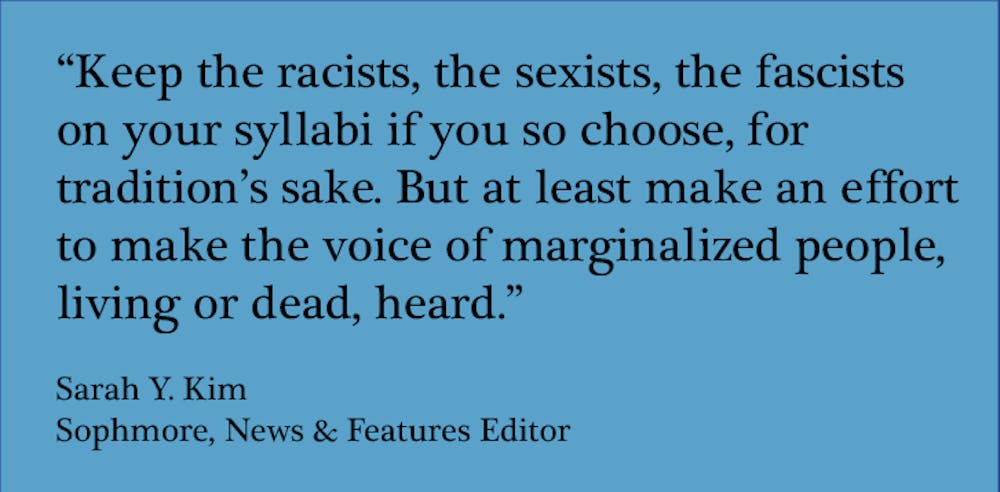Before #MeToo, I did not take a very close look at the personal lives of artists whose work I admired. I was naive enough to think that in the 21st century, I could not possibly have been conditioned to respect sexual offenders.
Now, #MeToo is still going strong, and living celebrities continue to fall swiftly from their pedestals. But I’ve begun to wonder how many artists who are now long dead are guilty of the same crimes.
I wonder how many of them are the writers we study in Writing Seminars classes.
We’ll never know exactly, and how convenient that is for literary academia. But there is a lot more we can know.
You may never be able to hear the voices of sexual assault survivors from long ago. But with a cursory Google search, you’ll find that many of the writers we are taught to look up to were misogynists, racists, anti-Semitic, homophobic, cultural appropriators and more.
Sometimes you don’t even need Google to tell you that. Their writing speaks for itself.
Where do we draw the line between the artist and their art? It’s a hackneyed question, but it’s worth exploring. I don’t think academia — let alone Hopkins — has done nearly enough to explore it.
#MeToo has forced me to continually examine that question. And I do not think it stops with sexual assault allegations.
Sure, you may argue that these racist, sexist writers in the literary canon were a product of their times, that I shouldn’t compare them to Weinstein. But the indifference so many had (and still have) toward sexual assault, men getting away with doing whatever they wanted — that is also a product of the times. And the times are changing.
We’re doing a better job of rejecting sexual offenders. What, then, stops us from rejecting the misogynists, the racists, the anti-Semites, the homophobes, the cultural appropriators, the (maybe) sexual offenders on our syllabi?
I already know the answer to that. University curricula are steeped in tradition, which in the U.S. means it has been shaped almost entirely by dead white men (and — woohoo! — some white women). These writers may leave a bad taste in our mouths, but they are aesthetically, culturally and historically significant. Et cetera, et cetera.
I hate to admit it, but it’s true. It’s impossible to look at writers today and not at all acknowledge their predecessors. If you’re a minority and/or woman and a Writing Seminars major, chances are your writing wouldn’t be the same without a dead white writer who would have been all too willing to dehumanize you. This doesn’t mean, however, that we can’t change the way that professors teach these writers.
I know that professors expect us to look up to the writers we read, to model our work after theirs. But it’s discouraging that our syllabi are dominated by white writers — most of them male. It’s even more discouraging to realize that many of them would have viewed me as subhuman.
In English classes, we do a better job of scrutinizing the authors we read. They are not presented as role models so much as historical figures.
Writing Seminars instructors should consider doing the same. Before telling us that we should be moved by so-and-so, that we should emulate so-and-so, our instructors need to do a better job of acknowledging the sins of these writers.
Moreover, they can make more of an effort to diversify their syllabi. Last semester, The News-Letter wrote an editorial and a feature on that very subject, and little has changed.
Keep the racists, the sexists, the fascists on your syllabi if you so choose, for tradition’s sake. But at least make an effort to make the voice of marginalized people, living or dead, heard.
For a long time, I did not even think of writing characters who looked like me. If white writers are all we’re taught to imitate, then the stories we feel free to tell are limited.
The stories you tell us to read do matter. The people who wrote them do matter.
Ask us then how we, as writers, can feel more represented and empowered. Tradition may matter, but the times are changing. We want to know that we matter, too.
Sarah Y. Kim is a sophomore Writing Seminars and International Studies major from Walnut Creek, Calif. She is a News & Features Editor of The News-Letter.





